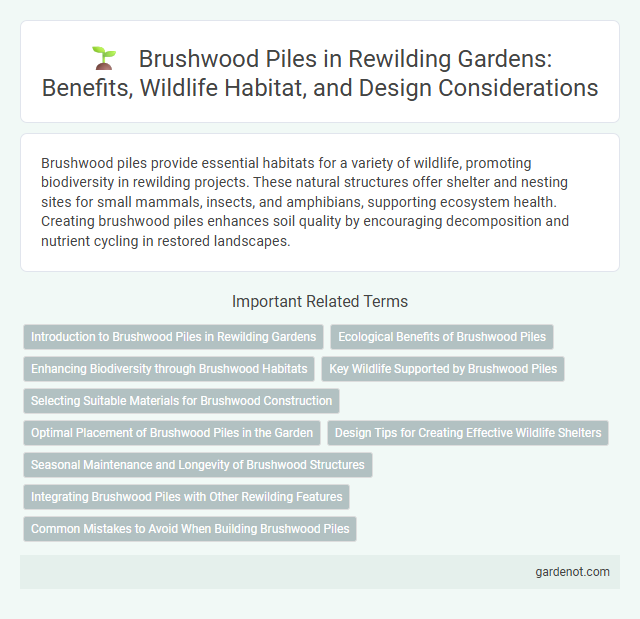Brushwood piles provide essential habitats for a variety of wildlife, promoting biodiversity in rewilding projects. These natural structures offer shelter and nesting sites for small mammals, insects, and amphibians, supporting ecosystem health. Creating brushwood piles enhances soil quality by encouraging decomposition and nutrient cycling in restored landscapes.
Introduction to Brushwood Piles in Rewilding Gardens
Brushwood piles are essential structures in rewilding gardens, providing natural habitats for insects, amphibians, and small mammals. These piles consist of cut branches, twigs, and brush that create shelter, nesting sites, and breeding grounds, promoting biodiversity. Integrating brushwood piles supports ecosystem regeneration by enhancing soil health and encouraging wildlife activity.
Ecological Benefits of Brushwood Piles
Brushwood piles provide essential habitats for a variety of wildlife, including insects, amphibians, and small mammals, enhancing biodiversity in rewilding projects. These structures promote natural decomposition processes, enriching soil fertility and supporting plant growth. By offering shelter and breeding sites, brushwood piles help maintain balanced ecosystems and sustain native species populations.
Enhancing Biodiversity through Brushwood Habitats
Brushwood piles create vital microhabitats that support diverse species including insects, amphibians, and small mammals, thereby enhancing local biodiversity. These habitats provide shelter, breeding grounds, and food sources, promoting ecological stability and resilience. Incorporating brushwood piles in rewilding projects fosters natural processes critical for ecosystem restoration and wildlife conservation.
Key Wildlife Supported by Brushwood Piles
Brushwood piles provide essential habitats for a variety of wildlife species, including small mammals like hedgehogs and voles, as well as insects such as beetles and spiders that thrive in the decaying wood. These structures offer shelter, breeding sites, and foraging opportunities, supporting biodiversity by creating microhabitats that enhance ecosystem complexity. Birds like wrens and robins also benefit from brushwood piles, using them for nesting and protection from predators.
Selecting Suitable Materials for Brushwood Construction
Selecting suitable materials for brushwood construction involves choosing locally sourced, untreated branches and twigs that provide natural habitat complexity and shelter for wildlife. Opt for a mixture of hardwood and softwood species to enhance biodiversity and structural stability in the brushwood pile. Avoid materials with chemical treatments or invasive species to ensure ecological safety and promote native ecosystem restoration.
Optimal Placement of Brushwood Piles in the Garden
Position brushwood piles in shaded or semi-shaded areas of the garden to create ideal habitats for insects, amphibians, and small mammals that contribute to biodiversity. Placing piles near native shrubs or woodland edges enhances shelter and foraging opportunities, promoting natural pest control and soil health. Ensure piles are stable and layered with variety in branch sizes to support a diverse range of wildlife and maximize ecological benefits.
Design Tips for Creating Effective Wildlife Shelters
Brushwood piles serve as essential wildlife shelters by providing habitat complexity and protection for small mammals, birds, amphibians, and insects. Design tips include using a variety of branch sizes to create densely packed layers that retain moisture and offer hiding spots, positioning piles in shaded, undisturbed areas near food sources, and ensuring the base has good ground contact to promote warmth and shelter from predators. Incorporating native brushwood and avoiding treated wood enhances ecological benefits and encourages biodiversity within rewilding projects.
Seasonal Maintenance and Longevity of Brushwood Structures
Regular seasonal maintenance of brushwood piles involves removing decomposed material and repositioning loose branches to sustain habitat quality and structural integrity. Ensuring proper drainage and avoiding excessive compaction prolongs the longevity of brushwood structures by preventing rot and promoting natural decomposition cycles. Strategic layering and periodic replenishment during autumn and spring enhance durability while supporting wildlife shelter and biodiversity.
Integrating Brushwood Piles with Other Rewilding Features
Brushwood piles enhance biodiversity by providing vital habitat and shelter for insects, amphibians, and small mammals, complementing other rewilding features such as wildflower meadows and native tree planting. Strategically placing brushwood piles near ponds and hedgerows creates interconnected wildlife corridors, facilitating movement and genetic exchange across the landscape. Integrating these structures with natural water features and native flora supports ecosystem resilience and promotes a balanced, thriving rewilding environment.
Common Mistakes to Avoid When Building Brushwood Piles
When building brushwood piles for rewilding, avoid using treated or diseased wood that can introduce toxins or harmful pathogens into the environment. Ensure the pile is dense enough to provide shelter for wildlife but not so compact that it inhibits airflow, which can lead to rot and discourage use by species like hedgehogs or amphibians. Position the pile away from heavy foot traffic and direct sunlight to maintain moisture levels and maximize habitat suitability.
Brushwood pile Infographic

 gardenot.com
gardenot.com